When you have hyperhidrosis, you’ll want to try a few treatments to see what works best for you specifically. Once you’ve tried the less intrusive ones (antiperspirants and wipes), you’ll want to try iontophoresis. Let’s go over what it is, and what are the pros and cons of using this.
What is iontophoresis?
Below in the left picture is how the iontophoresis machine I had looked like. I know, looks like a torture machine! :/. Nowadays I use a much more sophisticated iontophoresis machine from DermaDry called DermaDry Total as seen in the right picture.
In a nutshell, you have your hand or feet submerged in water and the machine sends electricity in the water. That electricity travels through your sweat glands and blocks them. If you’d like to learn more about how it works, this International Hyperhidrosis Society article has pretty good details.
To read detailed, real-life steps of what it looks like to go through an iontophoresis session, check my article here.
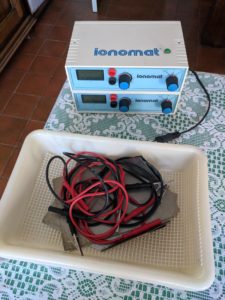
Where can I try & buy a iontophoresis machine?
Before buying my own machine, I had done some iontophoresis sessions at my dermatologist, so that was a good way to try the machine out and get the first instructions on how to use it. But going to the dermatologist 2-3 times a week after work was clearly not sustainable, so I ended up investing in getting my own iontophoresis machine. I doubt all dermatologists would have it in their offices, but it’s always worth asking when you chat with yours! And if they don’t have one for you to try out, maybe they can recommend a place or brand!
There are a bunch of brands out there: dermadry, ionomat, iontoderma, hidrex, and rafischer. These are the biggest brands. But I am not sure how they compare to each other. Currently, I have DermaDry Total because I believe it’s the best option on the market now, but I have been using Ionomat in the past as well because that’s what my dermatologist had at his office. Make sure you pick one that plugs into your country’s power outlets.
Does iontophoresis work?
You repeat these sessions 2-3 times a week. The more sessions you do, the more comfortable you’ll be to slightly increase the intensity a notch every time until you’ve reached the maximum level you feel comfortable with.
Iontophoresis worked for me.
It took a few weeks before I could feel the results. And then it requires a lot of patience and self-discipline because it’s tedious to set up and clean up, and it’s a bit painful honestly.
Procrastinators be careful though, because once you start seeing the results of your sessions, it’s easy to get into the bad habits of postponing sessions, doing them less often, etc. I kept finding excuses to postpone my sessions “I’m too tired/too busy/etc. and I will do it tomorrow”.
It only ‘works’ if you are serious about it and do it regularly.
Once you stop, you quickly get back to dripping wet hands and feet in a few weeks. I know because I got lazy and stopped doing it and voila!, I was back to square one and had to discipline myself all over again.
Pros:
- Works: The iontophoresis machine actually does work, and it is way less intrusive than going through surgery. The more you do it, the less often you will need to do it and the more you will be able to spread out sessions. But the regular sessions still need to go on.
- Works for ALL: It can be used for hands, armpits, and feet hyperhidrosis, so it can work for most of us.
Cons:
- Price: The cost of a iontophoresis machine is quite expensive. It varies based on: the brand, your insurance, and on whether you are only doing 1 thing (e.g.: the hands) or 2 things (hands and feet).
- Prices are roughly between $300 and $900.
- The way I see it though, is that the more you use it, the more the cost-per-use decreases. So, if you bought the machine for $400 for example and you do 2 sessions a week every week of the year, then each session really only costed you$3.84 (because $400/ (52 weeks * 2 sessions/week) … So it’s not that bad when you think of it in these terms right? And hyperhidrosis is so annoying to deal with that when you find something that works, you are willing to splurge! Think of it as an investment to stay sane!
If you think about the cost-per-use, your iontophoresis machine is not that expensive
- Painful: Let’s not lie, it DOES hurt. No pain, no gain, right? 🙂 Handling electricity’s up’s and down’s in your hands and feet is no fun. The sensation is tough to explain, but I would say it’s like a burning & ticklish feeling, both at the same time. Like if you sit on your feet or hands for too long. It is manageable though, but not something you look forward to doing for sure.
- Time: This was a big issue for me. The actual session is only 20 minutes so it’s manageable. You just watch a TV show while you do it. But there’s prep time to account for: setting up the machine, putting water in, doing the actual session, drying your hands and feet with a towel, emptying the water in a sink, drying the sheets of metal so they don’t rust, etc. So all-in, it’s more like 45 minutes. And you have to repeat this 2-3 times a week. It’s clearly more intrusive in your daily life than antiperspirants or solutions and wipes but it also works better.
- So I ended up just leaving the machine in a specific spot so it was always almost ready. But then you have guests over, they ask what that is, and you have to explain everything from scratch: what hyperhidrosis is, what the machine is, etc. But that’s great for Hyperhidrosis Awareness! I can’t remember the number of times I had to explain people what the whole deal was with that machine on my desk every time someone came over! 😊
- End date: There is no real end date. Once you start it, and if it works, then you’ll continue doing it regularly for years to come. As months go by, you won’t need to do it as regularly as in the beginnings tough. But you’ll still need to do it 1-2 times a week to keep the positive effects going.
Conclusion
There are quite a few con’s to using iontophoresis, but the biggest and most important pro is that it works! Hyperhidrosis is such a handicap to our daily lives that it’s worth the initial investment and the bi-weekly pain.
But after a few years I got tired of doing the weekly sessions. Because I was not doing the sessions seriously, I was still struggling with my hyperhidrosis. That’s when I knew it was time to seek a more permanent solution.
My doctor suggested botox, but I ended up not going for that solution, and I skipped to the next step, the ETS surgery.
Have you been considering iontophoresis? Have you tried it? What do you think?
Disclaimer: I’m not a doctor. I’m writing based on my own personal experience, and I added in some more details based off research. I’m simply giving you an overview of the options available to you to deal with hyperhidrosis, so you can have an understanding of what’s available when you talk to your doctor. Contrary to most things you will find online, this overview is not written from a medical or objective point of view, but written from the individual, unique, point of view of someone who went through most of the options. This is based on what I liked/didn’t like when I was trying each option.

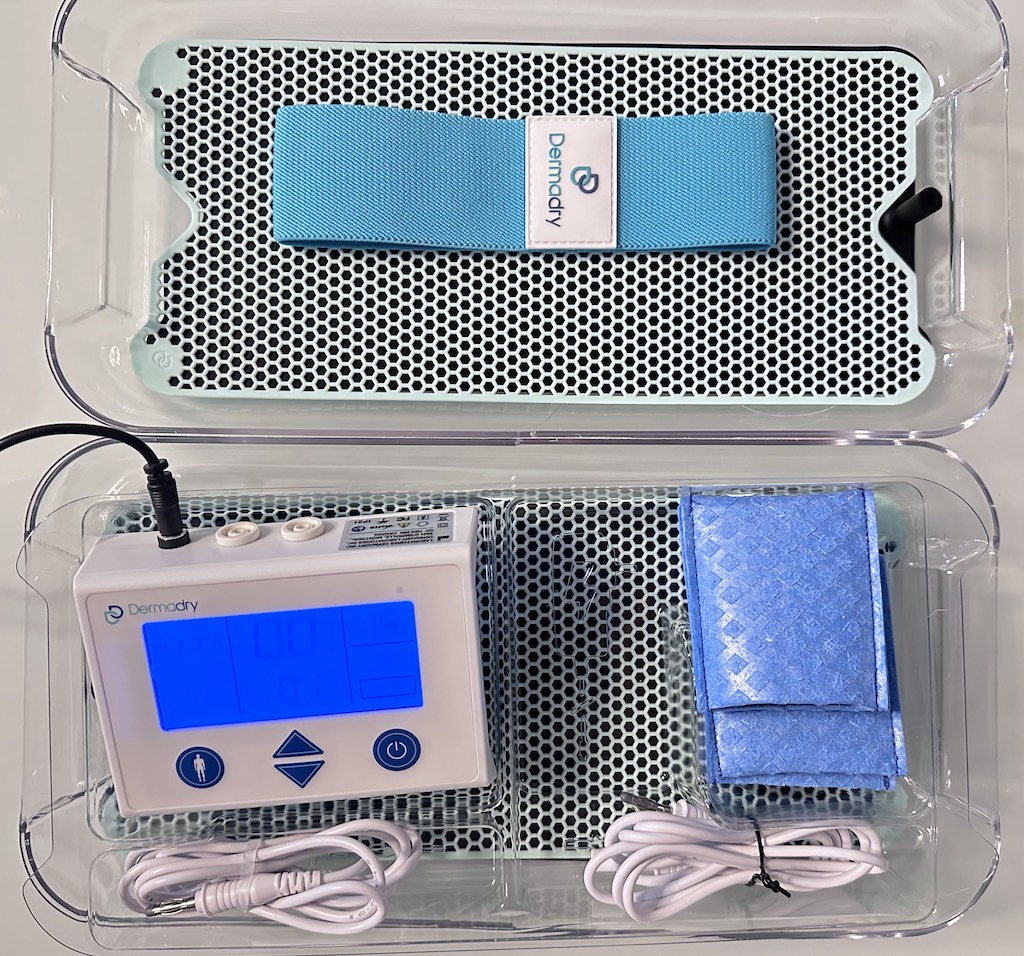
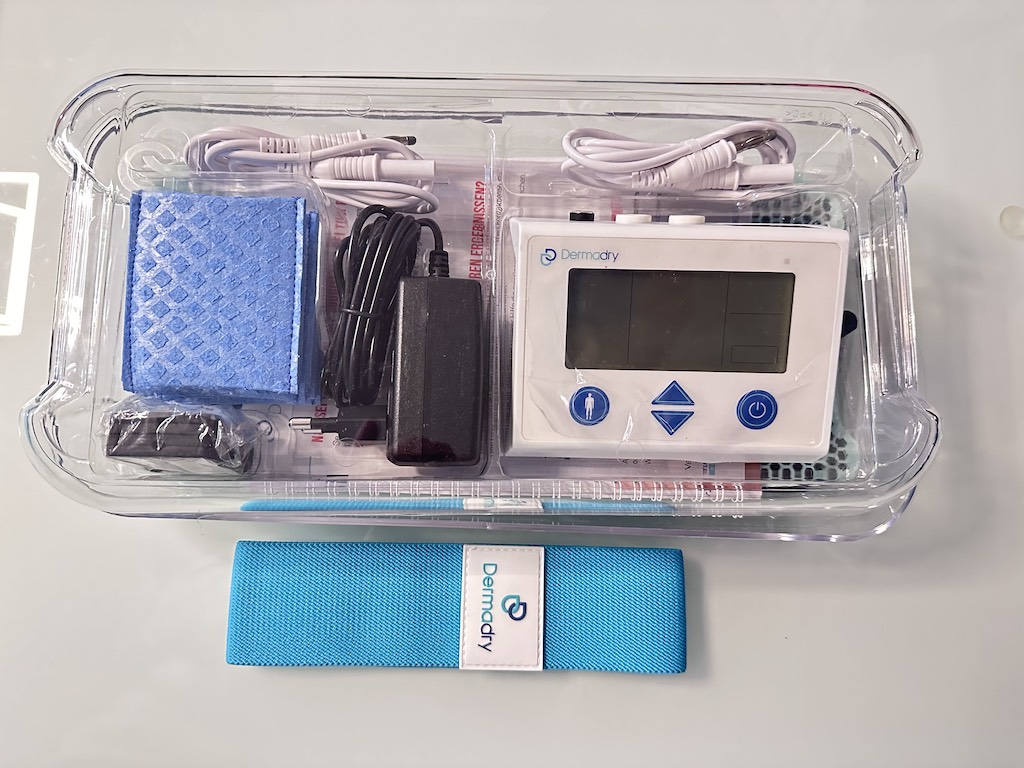
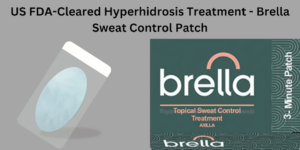
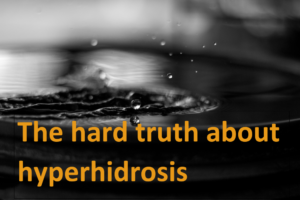

Pingback: What it's really like to use a iontophoresis machine - SweatySwaggy
Pingback: Treat hyperhidrosis with Aluminum lotions or Anticholinergic Wipes: the pros and cons - SweatySwaggy